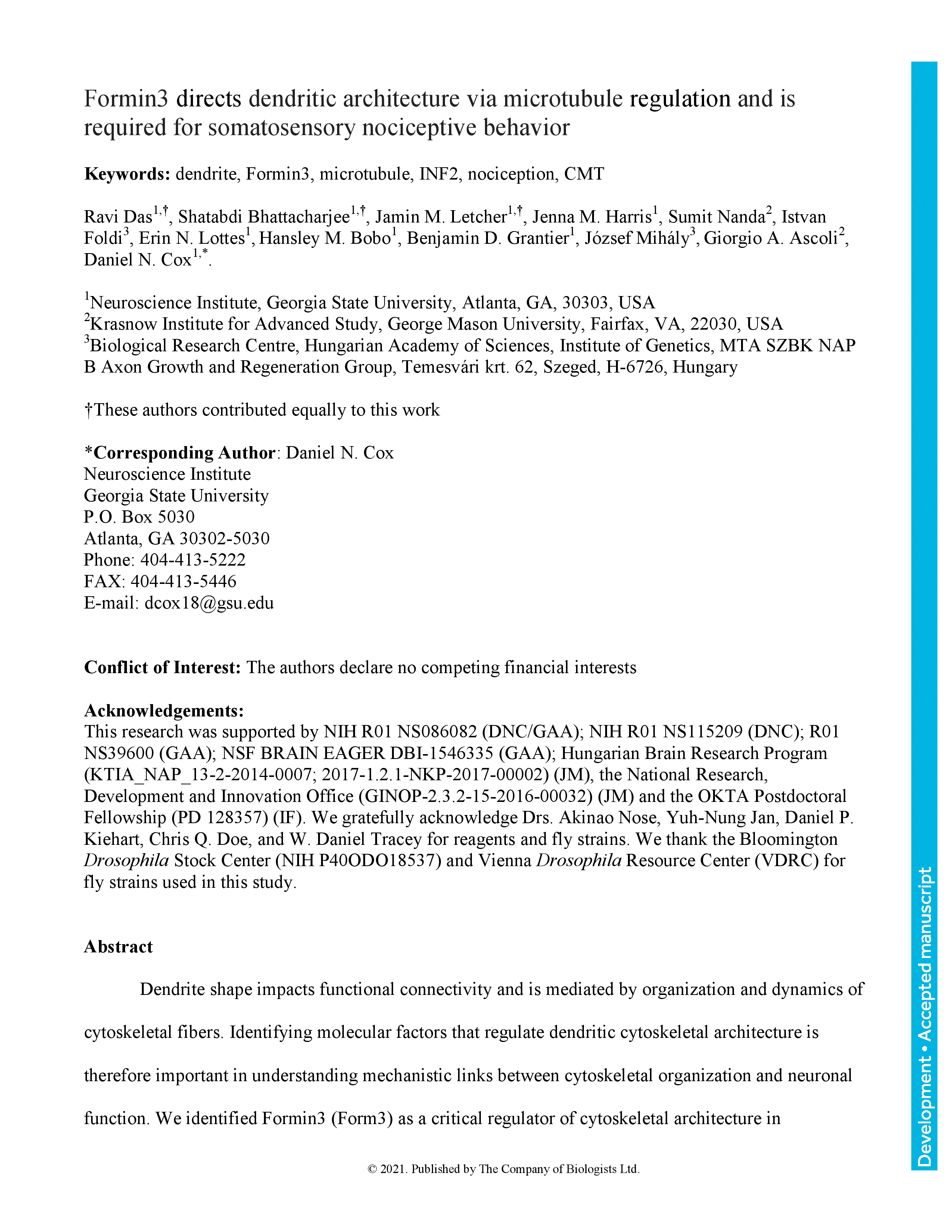Dendrite shape impacts functional connectivity and is mediated by organization and dynamics of cytoskeletal fibers. Identifying molecular factors that regulate dendritic cytoskeletal architecture is therefore important in understanding mechanistic links between cytoskeletal organization and neuronal function. We identified Formin3 (Form3) as a critical regulator of cytoskeletal architecture in nociceptive sensory neurons in Drosophila larvae. Time course analyses reveal Form3 is cell-autonomously required to promote dendritic arbor complexity. We show that form3 is required for the maintenance of a population of stable dendritic microtubules (MTs), and mutants exhibit defects in the localization of dendritic mitochondria, satellite Golgi, and the TRPA channel Painless. Form3 directly interacts with MTs via FH1-FH2 domains. Mutations in human Inverted Formin 2 (INF2; ortholog of form3) have been causally linked to Charcot-Marie-Tooth (CMT) disease. CMT sensory neuropathies lead to impaired peripheral sensitivity. Defects in form3 function in nociceptive neurons result in severe impairment of noxious heat-evoked behaviors. Expression of the INF2 FH1-FH2 domains partially recovers form3 defects in MTs and nocifensive behavior, suggesting conserved functions, thereby providing putative mechanistic insights into potential etiologies of CMT sensory neuropathies.
Formin3 directs dendritic architecture via microtubule regulation and is required for somatosensory nociceptive behavior
These authors contributed equally to this work
- Award Group:
- Funder(s): National Institute of Neurological Disorders and Stroke
- Award Id(s): NS086082
- Funder(s):
- Award Group:
- Funder(s): National Science Foundation
- Award Id(s): DBI-1546335
- Funder(s):
- Award Group:
- Funder(s): magyar Tudományos Akadémia
- Award Id(s): KTIA_NAP_1302-2014-0007
- Funder(s):
- Award Group:
- Funder(s): Hungarian Scientific Research Fund
- Award Id(s): GINOP-2.3.2-15-2016-00032
- Funder(s):
- Award Group:
- Funder(s): Hungarian Scientific Research Fund
- Award Id(s): PD 128357
- Funder(s):
Currently Viewing Accepted Manuscript - Newer Version Available
Ravi Das, Shatabdi Bhattacharjee, Jamin M. Letcher, Jenna M. Harris, Sumit Nanda, Istvan Foldi, Erin N. Lottes, Hansley M. Bobo, Benjamin D. Grantier, József Mihály, Giorgio A. Ascoli, Daniel N. Cox; Formin3 directs dendritic architecture via microtubule regulation and is required for somatosensory nociceptive behavior. Development 2021; dev.187609. doi: https://doi.org/10.1242/dev.187609
Download citation file:
Advertisement
Call for papers: Uncovering Developmental Diversity

Development invites you to submit your latest research to our upcoming special issue: Uncovering Developmental Diversity. This issue will be coordinated by our academic Editor Cassandra Extavour (Harvard University, USA) alongside two Guest Editors: Liam Dolan (Gregor Mendel Institute of Molecular Plant Biology, Austria) and Karen Sears (University of California Los Angeles, USA).
Choose Development in 2024

In this Editorial, Development Editor-in-Chief James Briscoe and Executive Editor Katherine Brown explain how you support your community by publishing in Development and how the journal champions serious science, community connections and progressive publishing.
Journal Meeting: From Stem Cells to Human Development

Register now for the 2024 Development Journal Meeting From Stem Cells to Human Development. Early-bird registration deadline: 3 May. Abstract submission deadline: 21 June.
Pluripotency of a founding field: rebranding developmental biology

This collaborative Perspective, the result of a workshop held in 2023, proposes a set of community actions to increase the visibility of the developmental biology field. The authors make recommendations for new funding streams, frameworks for collaborations and mechanisms by which members of the community can promote themselves and their research.
Read & Publish Open Access publishing: what authors say

We have had great feedback from authors who have benefitted from our Read & Publish agreement with their institution and have been able to publish Open Access with us without paying an APC. Read what they had to say.



